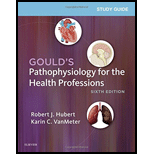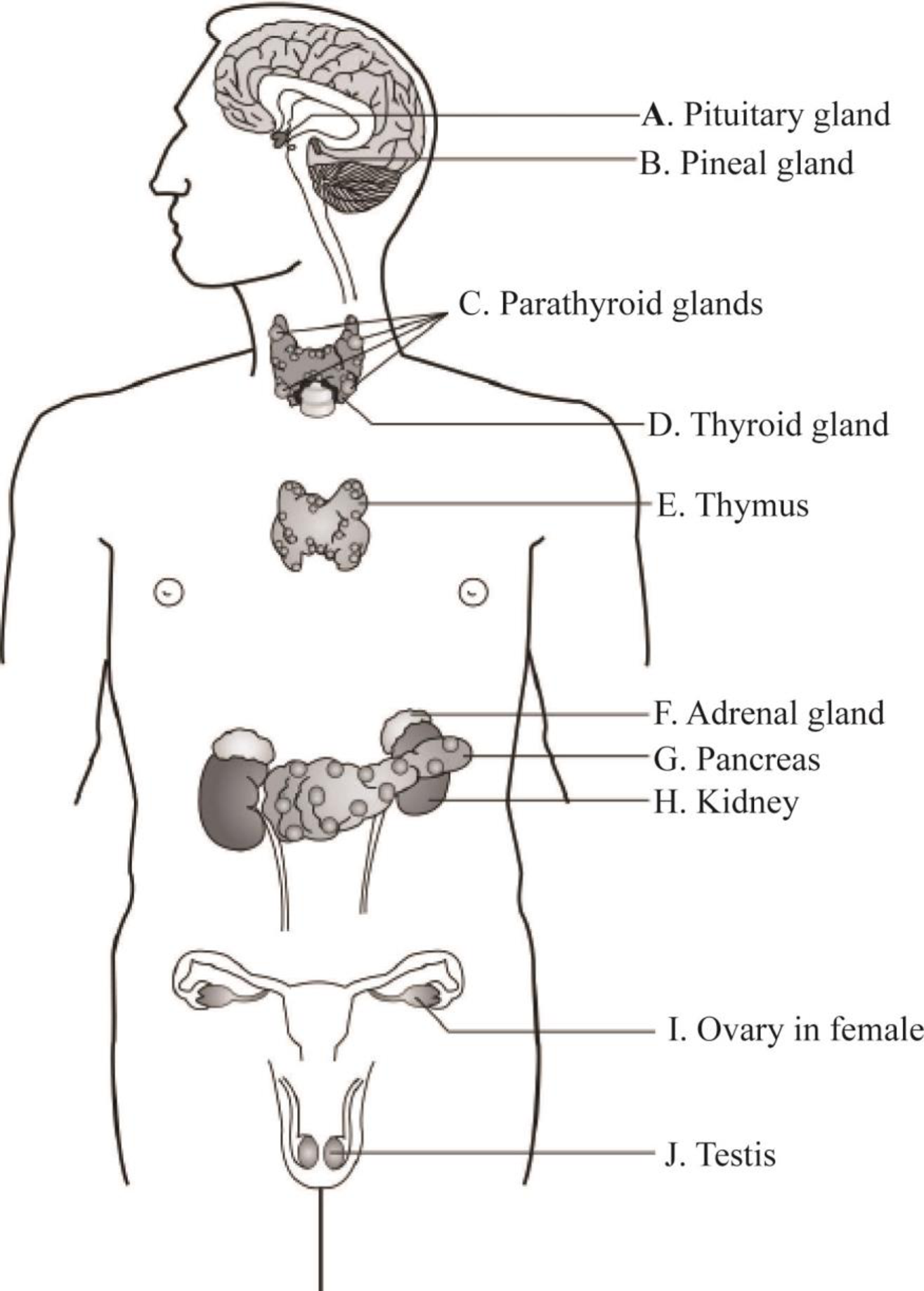
Study Guide for Gould's Pathophysiology for the Health Professions
6th Edition
ISBN: 9780323414142
Author: Hubert BS, Robert J; VanMeter PhD, Karin C.
Publisher: Saunders
expand_more
expand_more
format_list_bulleted
Question
Chapter 16, Problem 1P
Summary Introduction
To match: The given terms with the endocrine glands depicted in the diagram.
Introduction: The endocrine system is a chemical signaling system that uses the blood vessels as information channels. The endocrine glands are ductless organs located within the organ systems and contain groups of endocrine cells that secrete their hormones directly into their surroundings. Hormones are signaling molecules that help in regulating physiology and behavior.
Expert Solution & Answer
Answer to Problem 1P
Pictorial representation: Fig. 1 represents the different types of endocrine gland.

Fig.1: Different types of endocrine gland
Explanation of Solution
- A. Pituitary gland: The pituitary gland is located at the base of the brain and produce thyroid and follicle stimulating hormones, luteinizing hormone, and adrenocorticotropic hormone.
- B. Pineal gland: Pineal gland is a small, cone-shaped structure of the endocrine gland. It is composed of pinealocytes and glial cells (cells of nervous system) and connects the nervous system with the endocrine system. The hormone melatonin is secreted by the pineal gland.
- C. Parathyroid glands: Parathyroid hormone (PTH) is an important hormone secreted by the parathyroid glands.
- D. Thyroid gland: Thyroid gland is a butterfly-shaped endocrine gland and is enclosed within a connective tissue capsule. The thyroid gland is located near the neck.
- E. Thymus: The thymus gland is located behind the sternum and between the lungs. Thymosin, thymulin, thymopoietin, and thymosin are secreted by thymus.
- F. Adrenal gland: The adrenal glands are paired and pyramid-shaped endocrine glands. They are located on the superior surface of the kidneys.
- G. Pancreas: Pancreas is a glandular organ present in the abdominal cavity of a vertebrate, which helps for the regulation of sugar levels in the body.
- H. Kidney: The kidney is the major excretory organ present in human beings. It is a bean-shaped organ located at the back of the abdomen. The nephron is the functional unit of the kidney.
- I. Ovary in female: The ovary is an organ that is present in the reproductive system of females and it produces ovum. Females have a pair of ovaries. Ovary is important in the reproduction, as it is responsible for the production of female reproductive cells.
- J. Testis in male: Testis is the male reproductive gland. Testosterone is a steroid hormone produced by testes in males. This hormone is responsible for the development of secondary sexual characters.
Want to see more full solutions like this?
Subscribe now to access step-by-step solutions to millions of textbook problems written by subject matter experts!
Students have asked these similar questions
Introduction to health and social care
the Centers for Medicare and Medicaid Services to review the section on CMS' Value-Based Programs.
Identify two things that surprised or interested you.
please cite in text and list references.
what is evidence based practice and how is it important to Nursing?
Chapter 16 Solutions
Study Guide for Gould's Pathophysiology for the Health Professions
Ch. 16 - Prob. 1PCh. 16 - Prob. 2PCh. 16 - Prob. 3PCh. 16 - Prob. 4PCh. 16 - Prob. 5PCh. 16 - Prob. 6PCh. 16 - Prob. 7PCh. 16 - Prob. 8PCh. 16 - Prob. 9PCh. 16 - Prob. 10P
Ch. 16 - Prob. 11PCh. 16 - Prob. 12PCh. 16 - Prob. 13PCh. 16 - Prob. 14PCh. 16 - Prob. 15PCh. 16 - Prob. 16PCh. 16 - Prob. 17PCh. 16 - Prob. 18PCh. 16 - Prob. 19PCh. 16 - Prob. 20PCh. 16 - Prob. 21PCh. 16 - Prob. 22PCh. 16 - Prob. 23PCh. 16 - Prob. 24PCh. 16 - Prob. 25PCh. 16 - Prob. 26PCh. 16 - Prob. 27PCh. 16 - Prob. 28PCh. 16 - Prob. 29PCh. 16 - Prob. 30PCh. 16 - Prob. 31PCh. 16 - Prob. 32PCh. 16 - Prob. 33PCh. 16 - Prob. 34PCh. 16 - Prob. 35PCh. 16 - Prob. 36PCh. 16 - Prob. 37.1PCh. 16 - Prob. 37.2PCh. 16 - Prob. 37.3PCh. 16 - Prob. 37.4PCh. 16 - Prob. 37.5PCh. 16 - Prob. 37.6PCh. 16 - Prob. 37.7PCh. 16 - Prob. 37.8PCh. 16 - Prob. 37.9PCh. 16 - Prob. 37.10PCh. 16 - Prob. 38.1PCh. 16 - Prob. 38.2PCh. 16 - Prob. 38.3PCh. 16 - Prob. 38.4PCh. 16 - Prob. 38.5PCh. 16 - Prob. 38.6PCh. 16 - Prob. 38.7PCh. 16 - Prob. 38.8PCh. 16 - Prob. 38.9PCh. 16 - Prob. 38.10PCh. 16 - Prob. 38.11PCh. 16 - Prob. 38.12PCh. 16 - Prob. 38.13PCh. 16 - Prob. 38.14PCh. 16 - Prob. 38.15PCh. 16 - Prob. 38.16PCh. 16 - Prob. 38.17PCh. 16 - Prob. 38.18PCh. 16 - Prob. 38.19PCh. 16 - Prob. 38.20PCh. 16 - Prob. 38.21PCh. 16 - Prob. 38.22PCh. 16 - Prob. 38.23PCh. 16 - Prob. 38.24P
Knowledge Booster
Learn more about
Need a deep-dive on the concept behind this application? Look no further. Learn more about this topic, nursing and related others by exploring similar questions and additional content below.Similar questions
- what causes a variation in vital signs and how can we make adjustments?arrow_forwardAnalyze the traits that define a profession that nursing has attained?arrow_forwardHello, Can you help me please with the next case: Assessment (Recognizing Cues) Which client information is relevant? What client data is most important? Which client information is of immediate concern? Consider signs and symptoms, lab work, client statements, H & P, and others. Consider subjective and objective data. Analysis (Analyzing Cues) Which client conditions are consistent with the cues? Do the cues support a particular client condition? What cues are a cause for concern? What other information would help to establish the significance of a cue? Analysis (Prioritizing Hypotheses) What explanations are most likely? What is the most serious explanation? What is the priority order for safe and effective care? In order of priority, identify the top 3 client conditions. Thank you in advnce!arrow_forward
- Adult Case 1: Day 2—Questions 1. Write the Day 2 PN bag using a 2-in-1 formulation. 2. Would you increase dextrose to goal? 3. Would you add/continue ILE on Day 2? Why or why not? If so, what amount? 4. Assess and determine electrolyte additives. Assess calcium–phosphate compatibility. 5. What other additives would you include in the Day 2 PN? 6. Are there any additional interventions you would make? 7. What follow-up laboratory test results might be important to obtain for tomorrow morning?arrow_forwardAnalyze the traits that define a profession that nursing has attained?arrow_forwardEvaluate ways nursing has failed to attain its status as a profession?arrow_forward
- Discuss the difference between an occupation and a profession?arrow_forward1. Write goal PN macronutrients using a 2-in-1 formulation. 2. What consideration for amino acid concentration needs to be assessed? 3. Would you start this patient on goal dextrose for Day 1? 4. Would you add ILE on Day 1? Why or why not? If so, what amount? 5. Assess and determine electrolyte additives. Assess calcium–phosphate compatibility. 6. What other additives would you include in the Day 1 PN?arrow_forwardWhat impact do regulatory and accreditation standards have on the risk management process within health care organizations? Why do you think it’s important to understand how regulatory and accreditation standards affect risk management? Provide examples.arrow_forward
- you are a school nurse. in the last2 weeks, 9 cases of head lice have been reported in four different classrooms. The potential for spread is high, and both parents and teachers are growing anxious. compose a memo for distribution to the teachers. your goals are to inform, reassure, and direct future inqueries.arrow_forwardasked but not answers yet Language of Medicine 13th edition chapter 1 sections A-E exercise with answers onlyarrow_forwardwhat are the different types of assessments in the nursing process and when are they performed?arrow_forward
arrow_back_ios
SEE MORE QUESTIONS
arrow_forward_ios
Recommended textbooks for you
 Phlebotomy EssentialsNursingISBN:9781451194524Author:Ruth McCall, Cathee M. Tankersley MT(ASCP)Publisher:JONES+BARTLETT PUBLISHERS, INC.
Phlebotomy EssentialsNursingISBN:9781451194524Author:Ruth McCall, Cathee M. Tankersley MT(ASCP)Publisher:JONES+BARTLETT PUBLISHERS, INC. Gould's Pathophysiology for the Health Profession...NursingISBN:9780323414425Author:Robert J Hubert BSPublisher:Saunders
Gould's Pathophysiology for the Health Profession...NursingISBN:9780323414425Author:Robert J Hubert BSPublisher:Saunders Fundamentals Of NursingNursingISBN:9781496362179Author:Taylor, Carol (carol R.), LYNN, Pamela (pamela Barbara), Bartlett, Jennifer L.Publisher:Wolters Kluwer,
Fundamentals Of NursingNursingISBN:9781496362179Author:Taylor, Carol (carol R.), LYNN, Pamela (pamela Barbara), Bartlett, Jennifer L.Publisher:Wolters Kluwer, Fundamentals of Nursing, 9eNursingISBN:9780323327404Author:Patricia A. Potter RN MSN PhD FAAN, Anne Griffin Perry RN EdD FAAN, Patricia Stockert RN BSN MS PhD, Amy Hall RN BSN MS PhD CNEPublisher:Elsevier Science
Fundamentals of Nursing, 9eNursingISBN:9780323327404Author:Patricia A. Potter RN MSN PhD FAAN, Anne Griffin Perry RN EdD FAAN, Patricia Stockert RN BSN MS PhD, Amy Hall RN BSN MS PhD CNEPublisher:Elsevier Science Study Guide for Gould's Pathophysiology for the H...NursingISBN:9780323414142Author:Hubert BS, Robert J; VanMeter PhD, Karin C.Publisher:Saunders
Study Guide for Gould's Pathophysiology for the H...NursingISBN:9780323414142Author:Hubert BS, Robert J; VanMeter PhD, Karin C.Publisher:Saunders Issues and Ethics in the Helping Professions (Min...NursingISBN:9781337406291Author:Gerald Corey, Marianne Schneider Corey, Cindy CoreyPublisher:Cengage Learning
Issues and Ethics in the Helping Professions (Min...NursingISBN:9781337406291Author:Gerald Corey, Marianne Schneider Corey, Cindy CoreyPublisher:Cengage Learning

Phlebotomy Essentials
Nursing
ISBN:9781451194524
Author:Ruth McCall, Cathee M. Tankersley MT(ASCP)
Publisher:JONES+BARTLETT PUBLISHERS, INC.

Gould's Pathophysiology for the Health Profession...
Nursing
ISBN:9780323414425
Author:Robert J Hubert BS
Publisher:Saunders

Fundamentals Of Nursing
Nursing
ISBN:9781496362179
Author:Taylor, Carol (carol R.), LYNN, Pamela (pamela Barbara), Bartlett, Jennifer L.
Publisher:Wolters Kluwer,

Fundamentals of Nursing, 9e
Nursing
ISBN:9780323327404
Author:Patricia A. Potter RN MSN PhD FAAN, Anne Griffin Perry RN EdD FAAN, Patricia Stockert RN BSN MS PhD, Amy Hall RN BSN MS PhD CNE
Publisher:Elsevier Science

Study Guide for Gould's Pathophysiology for the H...
Nursing
ISBN:9780323414142
Author:Hubert BS, Robert J; VanMeter PhD, Karin C.
Publisher:Saunders

Issues and Ethics in the Helping Professions (Min...
Nursing
ISBN:9781337406291
Author:Gerald Corey, Marianne Schneider Corey, Cindy Corey
Publisher:Cengage Learning
Great Glands - Your Endocrine System: CrashCourse Biology #33; Author: CrashCourse;https://www.youtube.com/watch?v=WVrlHH14q3o;License: Standard Youtube License